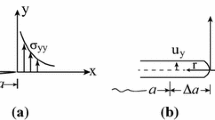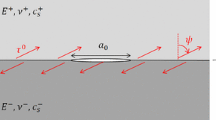Abstract
In this paper, the digital photoelastic technique was employed to investigate the effect of different material combinations and different crack inclination angles on the stress-intensity factors (SIFs). To produce a true bimaterial plate, the two component materials were naturally adhered together by a special casting procedure. The experimental results show that dimensionless combined SIF increases with increasingG 1/G 2 (or crack inclination angles) for different crack inclination angles (orG 1/G 2's).
Similar content being viewed by others
References
Erdogan, F., “Stress Distribution in Bonded Dissimilar Material with Cracks,”J. Appl. Mech.,32,403–410 (1965).
Rice, J. R. andSih, G. C., “Plane Problems of Cracks in Dissimilar Media,”J. Appl. Mech.,32,418–423 (1965).
Lin, K. Y. andMar, J. W., “Finite Element Analysis of Stress Intensity Factors for Cracks at a Bimaterial Interface,”Int. J. Fract.,12,521–531 (1976).
Wang, W. C. andChen, J. T., “Stress Analysis of Finite Interfacially Cracked Bimaterial Plates by using the Variational Method,”Computer Methods in Appl. Mech. and Eng.,73,153–71 (1989).
Wang, W. C. andChen, J. T., “Variational Analysis of Interfacial Stress Intensity Factors for Finite Bimaterial Plates under Biaxial Load,”Composite Structures,17,157–179 (1991).
Chiang, F. P., et al., “Determination of Stress Intensity Factors of Interfacial Cracks using Isochromatic Patterns,” Proc. 1989 SEM Spring Con. on Experimental Mechanics, 415–422 (1989).
Sur, J. G., et al., “Development of Photoelastic Experimental Method for the Measurement of Stress Intensity Factor Around the Interface Crack of Bimaterial,” Proc. VII International Congress on Exp. Mec., Las Vegas, 519–524 (June 1992).
Zak, A. R. andWilliams, M. L., “Crack Point Stress Singularities at a Bimaterial Interface,”J. Appl. Mech.,30,142–143 (1963).
Cook, T. S. andErdogan, F., “Stresses in Bonded Materials with a Crack Perpendicular to the Interface,”Int. J. Eng. Sci.,10,677–697 (1972).
Wang, W. C. and Chen, J. T., “Singularities at the Tip of a Semi-Infinite Crack Arbitrarily Inclined to and Terminated at the Bimaterial Interface,” The Fourteenth National Conf. on Theoretical and Appl. Mech., 279–287, Chung Li, Taiwan, R.O.C. (1990).
Sereda, V. E. and V. M. Finkel', V. M., “Interaction Between Fast Crack and Two-Media Interface,” Strength of Materials, 1426–1429 (1977).
Dally, J. W. andKobayashi, T., “Crack Arrest in Duplex Specimens,”Int. J. Solids and Struc.,14,121–129 (1978).
Theocaris, P. S. andMilios, J., “Dynamic Crack Propagation in Composites,”Int. J. Fract.,16,31–51, (1980).
Bogy, D. B., “On the Plane Elastostatic Problem of a Loaded Crack Terminating at a Material Interface,”J. Appl. Mech.,38,911–918 (1971).
Asbaugh, N. E., “Stress Solution for a Crack at an Arbitrary Angle to an Interface,”Int. J. Fract.,11,205–219 (1975).
Fenner, D. N., “Stress Singularities in Composite Materials with an Arbitrarily Oriented Crack Meeting an Interface,”Int. J. Fract.,12,705–721 (1976).
Bassani, J. L. andErdogan, F., “Stress Intensity Factors in Bonded Half Planes Containing Inclined Cracks and Subjected to Antiplane Shear Loading,”Int. J. Fract.,15,145–158 (1979).
Chen, J. T., “Theoretical and Experimental Investigations of Cracked Bimaterial Problems,” Ph.D. dissertation. Tsing Hua University, R.O.C., University Microfilms Intl. Pub. No. A151039 (1990).
Wang, W. C., “A Digital Imaging Algorithm for Extracting Stress Intensity Factor from the Photoelastic Fringe Pattern,”Eng. Fract. Mech.,36,683–696 (1990).
Sanford, R. J., “A Critical Re-examination of the Westergaard Method for Solving Opening-Mode Crack Problems,”Mech. Res. Commun.,6,289–194 (1979).
Sanford, R. J. andDally, J. W., “A General Method for Determining Mixed-Mode Stress Intensity Factors from Isochromatic Fringe Patterns,”Eng. Fract. Mech.,11,621–633 (1979).
Sawyer, S. G. andAnderson, R. B., “Collocated Interfacial Stress Intensity Factors for Finite Bimaterial Plates,”Eng. Fract. Mech.,4,605–616 (1972).
Statistical Analysis System User's Guide, 1979 ed., Raleigh, North Carolina: SAS Institute, Inc. (1979).
Author information
Authors and Affiliations
Rights and permissions
About this article
Cite this article
Chen, J.T., Wang, W.C. Experimental analysis of an arbitrarily inclined semiinfinite crack terminated at the bimaterial interface. Experimental Mechanics 36, 7–16 (1996). https://doi.org/10.1007/BF02328692
Received:
Accepted:
Issue Date:
DOI: https://doi.org/10.1007/BF02328692




